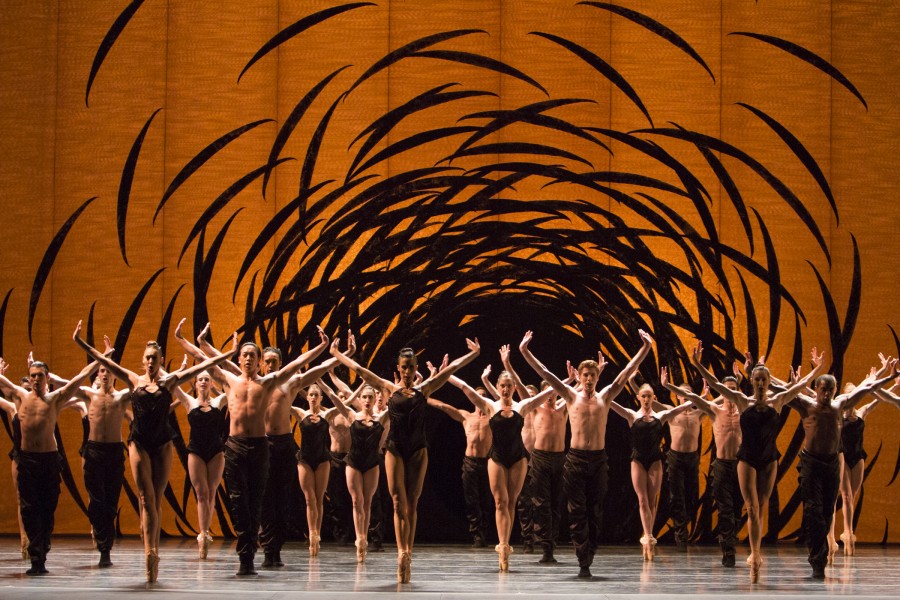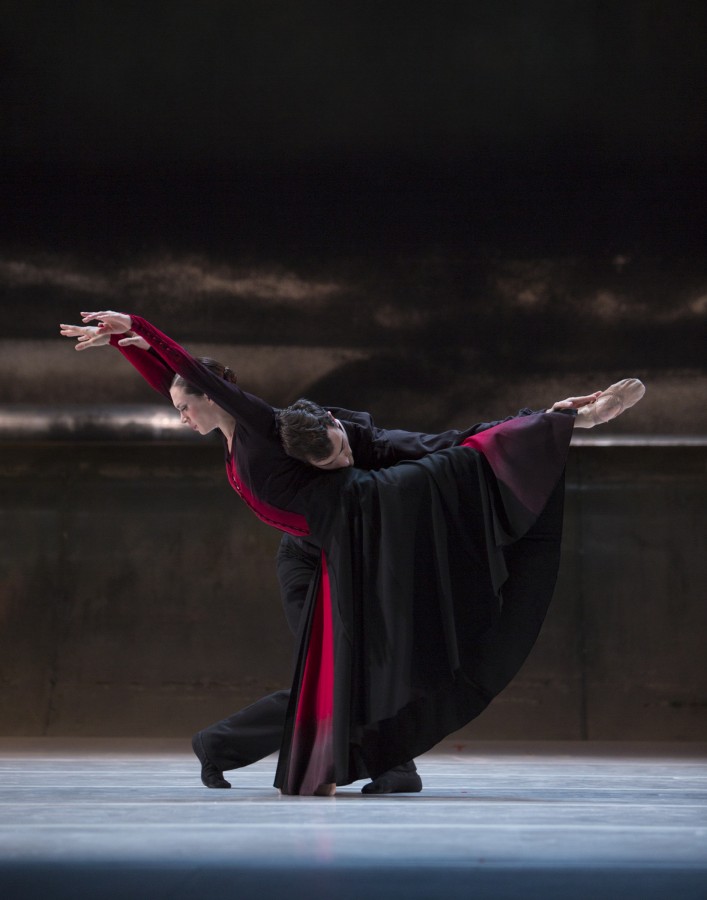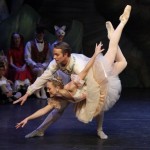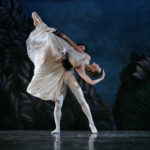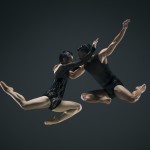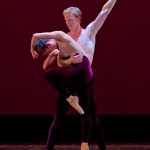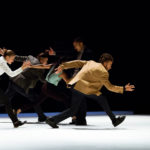Few programs explore the power of ballet to depict the human condition and the inhuman condition as beguilingly as Pacific Northwest Ballet’s recent offering of three modern classics by Jiří Kylián, brilliantly paired with Emergence, Crystal Pite’s spine-chilling parable of a sci-fi insect kingdom.
Program notes by Kylián for his own ballets are generally baffling. But who needs program notes when confronted with the magnificent, painterly scenic design of a raging storm at sea by John Macfarlane, the majesty of Benjamin Britten’s Sinfonia da Requiem, and the noble Rachel Foster and Jerome Tisserand, grieving over an unspecified loss?
Kylián’s Forgotten Land opens with six couples, their backs to us, striding slowly toward the sea, winds howling, followed by the portentous opening chords of the requiem with its apocalytic drumbeats. There are moments when the dancers resemble sea birds, especially in their swooping lifts, the women in long sweeping gowns, but mostly they are a proud tribe, coming to terms with some terrible calamity – perhaps the aftermath of a war or natural disaster, like the storm surge on the Philippine island of Leyte (surely an exemplar of a land “forgotten” by an unscrupulous, inept government.)
In the opening movement, Foster rarely looks at Tisserand, though they are tightly entwined; she is searching, with increasing urgency, perhaps for a lost child, whom together they are mourning. Maria Chapman and Steven Loch echo the sweeping movements of the first couple, Chapman’s exquisite feet and legs slicing through the air like scimitars.
Margaret Mullin and Jonathan Porretta are whirlwinds in red, flying across the stage in an astonishing series of turning leaps in the “Dies Irae,” whose origins lie in an ancient “dance of death.” The tranquil, redemptive final movement is led, movingly, by the elegant pair of Seth Orza and Elizabeth Murphy.
The evening opened with Petite Mort (orgasm, in the vernacular), Kylián’s daffy skewering of the mating ritual, set to two splendid Mozart adagios. It opens in silence, or rather, in the absence of Mozart, with six near-naked men brandishing fencing foils with an obsessive-compulsive ardor. They race downstage, tugging on a billowing shroud of black silk, from the depths of which emerge their female partners. The couples cavort in stylized whalebone underwear, the men more interested in fiddling with their fencing equipment than with the ladies, who occasionally careen on and off stage behind puffy black ballgowns on wheels – metaphors, presumably, for pompous social conventions.
Margaret Mullin and Jonathan Porretta get down to business in the first pas de deux, fluid and passionate, sharp angular movements dissolving into tender curves. Leah Merchant shows off her gloriously pliant back and arms in the second pas de deux, nobly supported by William Lin-Yee, while Lindsi Dec and Karel Cruz dispatch the third with an easy elegance.

Jonathan Porretta, Kylee Kitchens, James Moore and Leah Merchant in Jiří Kylián’s SECHS TÄNZE (Photo: Angela Sterling)
Sechs Tänze (Six Dances) reprises some of the motifs from Petite Mort, with Mozart in a zippier mood, but is poles apart in sensibility. At first glance, a dizzy comedy with vaudevillian overtones, this confection turns out to be at heart a brilliant deconstruction of Petite Mort: a peek at life backstage.
The curtain rises on dancers in deshabille: the women in petticoats with their ballerina buns comically “exploded” on top of their heads, the men with powdered wigs that have yet to be securely pinned down. They fidget and stare perplexedly out at the audience, as if at animals at the zoo – this is what dancers look like when they’re not performing. An exposed lighting grid, and a movable section of wall through which the dancers appear and disappear, confirm that we are backstage in the wings of a theatre; the actual performance is going on behind that wall. We see the black ballgowns fly by, the fencing foils thrust through them at wild angles.
The dancers entangle themselves in petty rivalries and backstage intrigues, culminating in a hilarious “decapitation” in which a giant dancer (a man standing on another man’s shoulders, disguised in one of those puffy ballgowns) lops the head off a normal-sized dancer (also behind one of those ballgowns). Even as we crack up, we are reminded of present-day intrigues backstage at the Bolshoi, with dancers hiring thugs to throw acid in the Artistic Director’s face.
Sechs Tänze is stuffed with virtuosic dancing, far more intricate than in Petite Mort. The upstart Mozart was accused by jealous rival Antonio Salieri of cramming “too many notes” into his music; Kylián deliberately matches every note with a step or gesture. Thursday night’s smashing cast were mostly debuts in this ensemble vehicle; no one missed a beat, and everyone acted up a storm, with a cascade of hilariously irreverent expressions on their faces.

The Radio City Music Hall Rockettes have nothing on the Pacific Northwest Ballet Dancers in Crystal Pite’s EMERGENCE (Photo: Angela Sterling)
Crystal Pite’s Emergence contains less dancing than the preceding pieces, but what compelling dance it is. The abstract hive-and-tunnel design by Jay Gower Taylor, sensationally lit in shades of pale whisky by Alan Brodie, the stylish black costumes and menacing Darth Vader-like headgear by Linda Chow, and the alarming electronic score by Owen Belton heighten the twitchy, hip-hop-inflected choreography. Recalling The Cage, Jerome Robbins’ grisly 1951 depiction of a matriarchal insect colony, Emergence opens with the birth of a new female member of the swarm: Margaret Mullin, who was having a very busy night, and who, with the midwifery assistance of William Lin-Yee, had to extract herself from some invisible gooey substance that pinned her to the stage.
Whereas Robbins was preoccupied with the mating behavior of his female predators, who target and devour the males after copulation, Pite concerns herself with loftier matters to do with governance and decision-making. She deploys her army of 38 dancers to amplify movement and create swells of emotion, sometimes in unison, sometimes in canon, but also in fascinating surges of movement that snake through the swarm in unpredictable fashion.
Male and female ensembles chase each other on and off stage, like b-boy and b-girl crews in competition; the women stab the floor with their sharp pointes, the men pop and lock and show off their finger pushups, their tattooed backs marking them as the Yakuza of the insect world. Pite injects menace into the classical vocabulary by taking away the usual transitions between steps, jerking body parts and convulsing the torso, to the sound of gravel crunching, water rushing, combat boots marching, and other reverberations from Belton’s thrilling electronic arsenal.
The only lapse in choreographic judgment was the vocal counting off of sections of the choreography by the women. Hearing them chant “1-2-3-4” robbed the spectacle of its eerie, otherworldly quality, momentarily reducing the theatrical experience to a mundane boot camp or A Chorus Line audition. The dancers could instead have been given some sinister, incomprehensible patter that would have preserved the atmosphere of dread.
– This review also appeared in the Huffington Post. –

